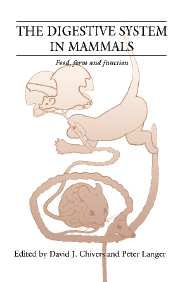Book contents
- Frontmatter
- Contents
- List of contributors
- Preface
- Part I Introduction
- Part II Food
- Part III Form
- Part IV Function
- 18 Foraging and digestion in herbivores
- 19 Gut morphology, body size and digestive performance in rodents
- 20 The integrated processing response in herbivorous small mammals
- 21 Digestive constraints on dietary scope in small and moderately-small mammals: how much do we really understand?
- 22 The effects and costs of allelochemicals for mammalian herbivores: an ecological perspective
- 23 Short-chain fatty acids as a physiological signal from gut microbes
- Part V Synthesis and perspectives
- Index
20 - The integrated processing response in herbivorous small mammals
Published online by Cambridge University Press: 18 March 2010
- Frontmatter
- Contents
- List of contributors
- Preface
- Part I Introduction
- Part II Food
- Part III Form
- Part IV Function
- 18 Foraging and digestion in herbivores
- 19 Gut morphology, body size and digestive performance in rodents
- 20 The integrated processing response in herbivorous small mammals
- 21 Digestive constraints on dietary scope in small and moderately-small mammals: how much do we really understand?
- 22 The effects and costs of allelochemicals for mammalian herbivores: an ecological perspective
- 23 Short-chain fatty acids as a physiological signal from gut microbes
- Part V Synthesis and perspectives
- Index
Summary
The amount of energy and nutrients that herbivorous mammals extract from a diet depends upon the amount of food eaten (intake) and its digestibility, but intake and digestibility do not vary independently. Apparent digestibility for any particular diet depends upon its chemical constituents, its retention time in the gastro-intestinal (GI) tract and the absorptive capacity of the GI tract. The last is a function of epithelial surface area and nutrient transport rates across the epithelium (Karasov and Diamond, 1988). Within limits, forage intake increases as the digestibility of the food decreases; retention time of food within the GI tract decreases as intake increases; and digestibility decreases as retention time decreases (Sibley, 1981; van Soest, 1982; Robbins, 1983). Retention time also decreases as the volume of the GI tract decreases. All of these variables (intake, retention time, GI size and digestibility) can change in response to changes in energy demand or fibre content of the diet (Hammond and Wunder, 1991). We call the relationships among these changes, and their effect on digestible energy (or nutrient) intake, the integrated processing response (IPR).
A wide variety of birds and mammals show an IPR, as indicated by changes in size, morphology and nutrient absorption rates of their GI tract with changes in diet quality (Gross et al., 1985; Karasov and Diamond, 1988; Brugger, 1991 and references therein). The IPR of small mammals is particularly interesting because a considerable body of theory, primarily based on ruminants, argues that small mammals (adult mass less than 1 kg) should not be able to meet their energy requirements on high fibre diets, such as mature grass (Demment and van Soest, 1985).
- Type
- Chapter
- Information
- The Digestive System in MammalsFood Form and Function, pp. 324 - 336Publisher: Cambridge University PressPrint publication year: 1994
- 15
- Cited by



